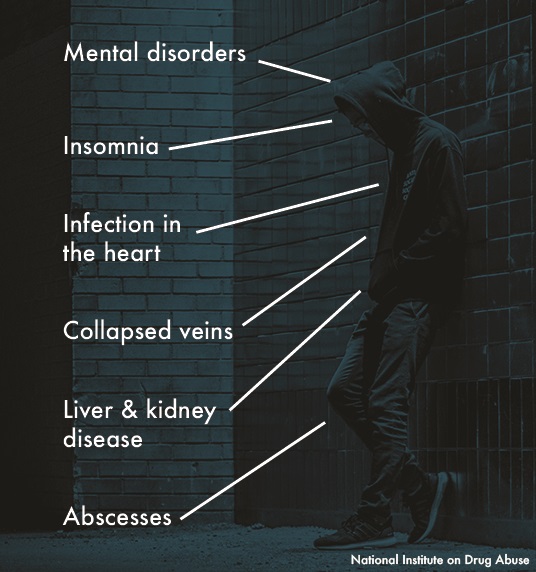What is Heroin & Heroin Signs of Use

Heroin is an opioid drug derived from morphine, a naturally occurring chemical found in the opium poppy plant. Heroin use has increased United States due to a variety of factors, including the opioid crisis. For people dealing with addiction to prescription opioids, they lose access in some way and turn to heroin, which is cheaper and easier to access. In a study done with national-level, general population, the National Institute on Drug Abuse (NIDA) found that, “…nearly 80 percent of heroin users reported using prescription opioids prior to heroin.” Understanding the factors behind addiction is incredibly important in treatment and in preventative action.
Heroin use and legality varied in the past, with more people using opium. Opium is derived from the poppy seed, which heroin is created from when processed. Heroin is more potent than opium, which was historically used for medical purposes. It was not until the early 1900s that the government started regulating opium use and in 1924 the Heroin Act prohibited the manufacturing, importation, and possession of heroin, even for medicinal use. There is still no acceptable medical use of heroin in the United States, though some have called for implementing and regulating medical use in certain cases. This is unlikely to happen anytime soon, especially because heroin carries a high risk for addiction. There are risks, including overdose, even with short-term use of heroin, and long-term use can be seriously damaging.
WHAT DOES HEROIN LOOK LIKE AND HOW IS IT USED?
It’s possible for heroin to be a white or brown powder, or a black sticky substance, which is referred to as black tar heroin. The whiter heroin is, the more pure it is. Snorting heroin and smoking heroin are some of the ways that people ingest heroin, as well as sniffing. They might start with injecting heroin, though often that will happen after some time when they need to feel the effects faster and stronger. Injecting heroin also begins to leave physical signs that people often want to hide. Heroin track marks are some of the more obvious physical signs of heroin use.
Speedball is a mixture of cocaine with heroin or morphine, a stimulant and a depressant respectively. Often people use the combination with the hopes of enhancing the positive effects, while reducing the negative effects. NIDA explains, “Respiratory failure is particularly likely with speedballs because the effects of cocaine wear off far more quickly than the effects of heroin. Fatal slowing of the breathing can occur when the stimulating cocaine wears off and the full effects of heroin are felt on their own.” Furthermore, with the combination there is the risk of death due to stroke, heart attack, or aneurysm. There has been somewhat increased awareness due to the deaths of public figures like River Phoenix, Philip Seymour Hoffman, John Belushi, and Chris Farley. Still, people often assume they will take only enough to feel the effects and that they can guard against overdose.
MountainView Recovery
5475 Mark Dabling Blvd #102
Colorado Springs, Co 80918
Contact Us Today!
MountainView Resources!
HEROIN USE IN AMERICA & THE OPIOID EPIDEMIC
From the 2017 National Survey on Drug Use and Health (NSDUH), “About 494,000 people aged 12 or older were current heroin users in 2017…” This number has increased over the years, and likely has since then due to the ongoing opioid crisis.
Historically, at least in the United States, heroin use has been seen as something that poor and marginalized communities use. In the 1990s, heroin use increased, partly from purity and safer use, and this helped create the image of “heroin chic”. It started to become a recreational drug, particularly for young, middle-class users. The heroin chic image was seen in movies (Trainspotting, Kids, Pulp Fiction), in fashion with models that looked as if they used heroin, and grunge music. This trend did start to fade and heroin was once again seen more as a drug used by the poor and marginalized. In recent years however, heroin is again becoming common in various demographics.
This time, it is not so much a trend as a result of a variety of factors including the use of opioid prescriptions. Most prescription opioid use that leads to heroin use was illicit use of opioids. Still, there are certainly a number of people using opioid for medical reasons, who have no intention of ever using heroin. Prescription opioids vary in strength, and should only be used under medical supervision of course, but they still carry a significant risk for addiction. Many need long-term pain management, which often feels unbearable if medication is stopped. Once people lose access to opioids they might turn to heroin, which is cheaper and easier to get.
The National Bureau of Economic Research found strong evidence that during economic downturns, there were increases in substance abuse disorders which involve prescription painkillers. This helps explain why areas of the country that are particularly hard hit by economic downturns also see high rates of abuse, addiction, and overdose.
SIDE EFFECTS OF HEROIN USE
The initial appeal of heroin is generally using it for pain management. In addition, people using heroin typically feel a heightened sense of euphoria and pleasure. Over time though, anyone using heroin will begin to build up a tolerance and they will need to use more heroin to be able to feel that euphoria and pain relief. Often, this leads to injecting heroin, if they have not already. As mentioned above, this results in heroin track marks, which are one of the more obvious physical signs of heroin use.
According to NIDA, short-term effects of heroin use include:
- Dry mouth
- Heavy feeling in the arms and legs (“heavy arms”)
- Nausea and vomiting
- Clouded mental functioning
- “On the nod”, a back-and-forth state of being conscious and unconscious
Long-term effects include:
- Insomnia
- Collapsed veins, via injection
- Infection of the heart lining and valves
- Abscesses
- Liver and kidney disease
- Mental disorders
Injecting drugs also increases the risk of contracting infectious disease like HIV or Hepatitis C when equipment (i.e., needle) is shared.


HEROIN SIGNS OF WITHDRAWAL AND OVERDOSE
Heroin withdrawal can be severe, especially if someone is addicted and suddenly stops using. NIDA states that withdrawal can begin as soon as a few hours after heroin was last used. Some of the symptoms include:
- Restlessness
- Severe muscle and bone pain
- Diarrhea and vomiting
- Cold flashes with goosebumps
- Severe heroin cravings
In addition to the symptoms above, NIDA cites research that has shown, “…some loss of the brain’s white matter associated with heroin use, which may affect decision-making, behavior control, and responses to stressful situations.” This combined with the severity of symptoms listed above make it incredibly difficult to go through heroin withdrawal without professional help.
Heroin overdose is absolutely possible and unfortunately heroin overdose deaths have increased. It is a potent drug on its own and if someone takes a high enough dosage they can overdose. Increasingly, heroin is cut with fentanyl, a cheaper, synthetic opioid, which is even more potent and causes overdose even in small amounts. With the risk of fentanyl in heroin, someone might overdose even if they are not using a particularly high dose of heroin.
With overdose, someone’s breathing will slow or stop. Even if a person is found, without the obvious signs of drug use, it can appear that the person is simply sleeping. For this reason, a number of overdoses are missed until it is too late. NIDA explains that the slow or stopped breathing can result in hypoxia, decreased oxygen to the brain, and it’s possible this will result in coma or permanent brain damage.
TREATMENT FOR HEROIN USE, ADDICTION, AND RECOVERY
With the opioid crisis in the United States, more people are aware of the risks and how to treat overdose. Naloxone is a medication that is usable as an injectable solution, an auto-injector, and a nasal spray. For friends and family with loved ones who struggle with heroin addiction, this is a life-saving tool to keep on hand. Even if it is used, it’s still important to get someone to a hospital for further treatment if they need more medication or medical help. Due to the severe physical pain and cravings with withdrawal, medical treatment is essential in initial recovery. There are a number of federally approved and regulated medications available. They include lofexidine, naltrexone, buprenorphine, and naloxone. They bind to the same opioid receptors as heroin, though the effect is weaker to reduce cravings and withdrawal symptoms.
Behavioral treatment is also effective, including cognitive-behavioral therapy (CBT) and motivational therapy. CBT is meant to help adjust behavior, thoughts, and feelings to avoid falling back into habits that led to substance abuse and addiction in the first place. It’s also meant to help people learn coping skills for when something difficult happens, so that they no longer turn to substances to cope. Motivational therapy is meant to offer incentives, like vouchers or small cash rewards for sobriety. Withdrawal and continued sobriety from heroin is difficult, but not impossible. It’s safer and easier with professional help. Mountain View Recovery also offers an alumni program, with no time limit, where clients will have support and learn life-skills. A solid community is essential for anyone’s recovery. It’s a complex process, and one that is life-long, which is easier to do with help. If you or a loved one needs help, reach out today.
Mountain View Recovery Treatment Programs
Patient Resources
Addiction is complex, which means treatment and long-term recovery are complex. Despite this, it shouldn’t scare anyone – patients or their loved ones. It just means that treatment and recovery both require thorough and thoughtful planning.
Outpatient Program
Our outpatient program (OP) is a transition preparatory phase. It provides a minimum of nine (9) hours of weekly outpatient treatment. This involves a minimum of one (1) hour/s individual substance abuse/behavioral health counseling per week.
Adventure Therapy
For a long time, nature has been seen as a balm to the problems we face in society. Even during pre-industrial times, people would seek out the countryside as a means to feel better. Many people have also used nature as a way to understand the world.
Trauma and Recovery
Just like physical trauma occurs, so does psychological trauma. Any number of traumatizing events occur and cause psychological trauma. A lot of people will experience trauma before or because of addiction. It’s possible for addiction to deepen…
Neurofeedback
Nobody sets out with the intention of becoming addicted to anything. Even someone making a conscious decision to try substances is not intending to become dependent, experience withdrawal, and risk overdose or death. There are numerous factors.
